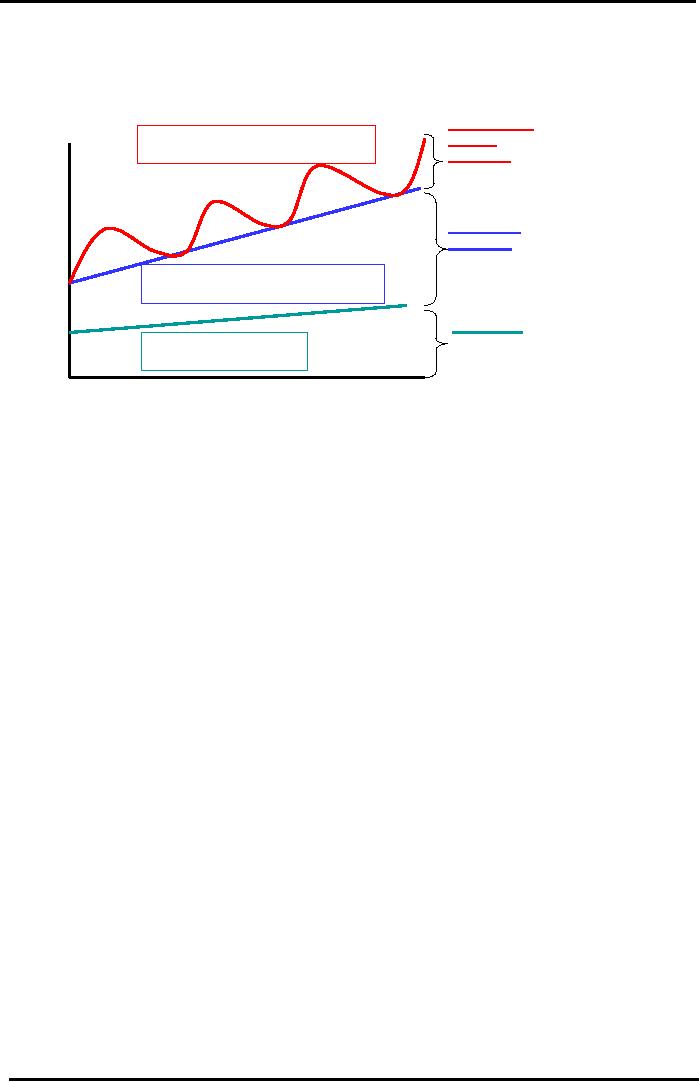 |

Financial
Management MGT201
VU
Lesson
41
SHORT
TERM FINANCING, LONG TERM
FINANCING AND LEASE
FINANCING
Learning
Objectives:
After
going through this lecture,
you would be able to have an
understanding of the following
topics:
·
Financing
(Short Term and Long
Term Financing)
·
Lease
Financing
In
this lecture we shall
continue our discussion of
working capital financing and
will discuss
financing,
short
and long term financing and lease
financing.
Working
Capital Financing:
·
Financial Managers spend
More than 50% of their
time on Working Capital
Financing. This has
been
observed in many companies. In other
words, arrangement for funds to meet
day-to-day
expenses
like inventory, raw material
supplies and miscellaneous expenses has great
significance.
·
Sources
of Financing
Permanent
Financing:
Permanent
Financing comes in two
forms:
·
Long-term Loans / Bonds Duration of
this source is More Than 1
Year. It has
Low
Risk for Firm but
has High Cost
·
Common Equity / Stock -
"Perpetual." By definition. Less
Risk for Firm
but
Highest
Cost.
Recall
here concepts of cost of
debt and cost of equity we
studied in capital structure to
decide
which source of financing is
better for firm and
why?.
Temporary
Financing:
Temporary
financing also has two
forms:
·
Short-term Loan (An
example of working capital
financing) Duration of
this
source
is Less Than 1 Year i.e. 3
months, 6 months, 9 months, etc. Easier to
obtain
than
Long-term Loan as for long
term loans many requirements like
financial
statements
and guarantees need to be
fulfilled. Less costly than
Long-term Loan
due
to lower interest rate generally. But
this interest costs is variable /
uncertain as
you
have to renew it each time and
you are not sure
whether you will get the
same
lower
interest rate as before. So More
risky. Needs to be rolled
over frequently so it
is
less liquid.
·
Spontaneous Financing - Current
Liabilities like Trade
Credit and Accrued
Taxes
(payable)
and Wages payable form
its base. Arise
"Spontaneously" from
day-to-day
operations.
It is in the form of money you have to
pay but have not paid
yet to your
suppliers.
It is free loan or credit on
which you do not have to pay
any interest. As
you
do not know the amount of money
you will have and when, there is
Highest
Uncertainty
/ Risk. It has Least Cost
(can be free!). But you
cannot depend on it for
day-to-day
expenses as this all is just
your rough idea. You are
not sure.
·
Tradeoff
between Liquidity (Risk) &
Profitability (Return)
High Current Assets
means High Liquidity but
Low Profitability. This is due to
more
money
tied in current assets that
have low profitability.
Low Current Assets
means High Profitability but
High Risk. This is due to
money tied
in
fixed assets may not be
available for payments as
they come due.
High Long-term Debt
means Low Risk of
illiquidity but High Cost of
Debt in form of
interest.
High Current Liabilities
(or short-term Spontaneous Financing
like Trade Debt)
means
Low
Cost but High Risk of
illiquidity.
169

Financial
Management MGT201
VU
Graphical
View of Financing
Maturity
Matching Principle
Match
the Maturity of Financing to
Usage of Asset
Spontaneous
Value
(Rupees)
TEMPORARY
CURRENT ASSETS
Current
Usage
Less than 1 Year
Liabilities
&
Short
Term
Financing
Short
Term
Financing
&
Long
Term
"PERMANENT"
CURRENT ASSETS
Financing
Usage More than 1
Year
Long
Term
Debt
&
FIXED
ASSETS
Equity
Usage
More than 1 Year
Time
(Months)
If
a firm uses long term
financing it has higher cost
of financing comparatively due to
high
interest
cost of long term loans. Despite of this
high cost you have low
risk here due to surety of
access
to
money for a longer period.
Current liabilities as a source of
financing are not reliable
as you have no
surety
whether you will have same
amount of money available next
month for financing or less
amount
of
money or how much money.
Also, if firm keeps continue
this practice and do not pay
its accounts
payable
will raise so much after a
period that it may go
bankrupt.
How
Much Liquidity to
Keep?
·
Keep enough Liquidity to
meet maturing short term obligations
(i.e. Accounts Payable,
Interest,
etc)
on time. How much firm
should keep of short term loans and how
much of long term
loans?
The decision is made keeping
in view the following
principles:
·
Hedging
Principle (or Principle of
Self-Liquidating Debt or MATURITY
MATCHING)
Match Cash-flow characteristics of
Asset being purchased with the
maturity of the
Source
of Financing used to buy the
asset.
·
Example:
Shoe
Shop Owner can use Current
Liability to finance seasonal
expansion in
inventory
during Eid Time. If he uses
Long-term financing, then
excess / surplus / IDLE
LIQUIDITY
GIVING LOW / NO YIELD BUT COSTING
INTEREST SO LOWER
PROFITS.
Eid
does not come each
month. Shop owner needs
extra money / inventory only
for one month.
He
should take short term loan. If he
decides to take long term
loan he will have to pay for
extra
interest
cost unnecessarily.
·
Another
way of describing the hedging
principle is Permanent Asset Investments
should be
financed
by Permanent Financing. Buy
Temporary Assets through
Temporary Financing.
Permanent
Asset Investments: Fixed
or Movable or EVEN CURRENT
assets (i.e.
Inventory)
that a firm plans to hold
for > 1 Year. The economic
life of such assets
can
be
more or less.
Temporary
Assets: Current
Assets that will be
liquidated within 1 year.
These are a
subset
of current assets. Foe example,
inventory in use for less
than 1 year.
·
Example:
Use
Long Term Loan to buy a
long term asset. Studio
owner should Do NOT
use
short-term
loan (< 1 Year) to buy a sophisticated
professional Sony Digital
Camera costing
Rs.1.5
million which is expected to have an
Economic Life of over 5
years and has a
Payback
Period
of 2 Years. Use Long Term
Loan with Maturity over 2
Years so that there is
sufficient
time
to repay interest from cash
flows of asset (i.e.
Camera).
170

Financial
Management MGT201
VU
Working
Capital Financing
Policies:
Total
Assets = Fixed assets +
Permanent Current assets +
Temporary Current
assets.
Total assets steadily
grow with life of healthy
company.
Temporary Current fluctuates
with time. Extra spontaneous
inventory can be
financed
by
short-term debt financing or
loan
This
will help us to understand which
kind of policy should firm
adopt according to the kind
of
assets
a firm have.
·
3
Policies of Working Capital
Financing (Based on Hedging Principle of
Maturity
Matching)
Aggressive
·
Maximum Short-term financing at
low cost (but risk of
non-renewal)
·
Use short-term financing for
Temporary Current Assets and even
partly to buy
Permanent
Current Inventory
Conservative
·
Maximum Long-term financing.
Safe but higher interest
costs.
·
Use long-term financing
for Fixed Assets, entire
Permanent Assets, and even
part
of Temporary Current
Assets
Moderate
·
Balance of Long and Short-term
Financing. Based on Maturity
Matching
Principle.
·
Long Term permanent Financing
for Fixed assets like
land, building,
warehouse,
machinery and Permanent
Current Assets only.
·
Spontaneous financing or short term
financing is used for short term
portion of
current
assets
Long-term
Debt Financing:
·
What
Affects Financing Decisions (Factors influencing
the choice of long term
finance by
managers)
Capital Structure: match
Actual Capital Structure to Optimum.
"Sticky", non-smooth,
never-ending
process. It is not one day
work.
Maturity Matching (Hedging
Principle): match maturity of
debt to asset usage
time
Interest Rates: get long-term
financing if long-term interest rates
are low
Financial Health &
Credit-worthiness: get long-term
financing while firm is
still
healthy
·
Short-term
Debt
Bank Loans: Maturity
period < 1 Year. Collateral
(security) required i.e.
Property,
inventory,
or a/c receivables.
Commercial Paper: unsecured
promissory note issued by
large, strong firm
·
Long-term
Debt Financing (Maturity Longer than 1
Year)
The
following are the forms of
this loan:
Bank "Term Loans": > 1
Year
Bonds: Debentures vs. Mortgage
vs. Floating Rate
Syndicated Loan: for
large loans, one lead bank
heading team of other banks.
Due to
large
amount of loan one bank alone cannot
take the whole risk and
liability.
Project Financing: for
large international infrastructural
projects i.e. Electric
power
plants,
dams, development of highways.
Group of firms invest equity
capital in a New
Project.
Bank gives loan to New
Project. In return, bank is
repaid from cash flows
of
the
New Project. In fact, Bank
gets the cash inflows first
and then decides what to
do
with
them! No other collateral or security is
provided. So individual assets of
each of
individual
firms is free. So bank
protects itself by keeping
control of all the cash
flows.
Securitization: convert private
debt contract into publicly traded
financial instrument. A
large
loan can be divided into
smaller parts that are traded in the
money markets.
171

Financial
Management MGT201
VU
Lease
Financing
·
Leasing
of Fixed Assets (Financing of Capital
Expenditure in Fixed Assets)
Leasing Company (Lessor) buys and
owns the asset and leases it to the
Lessee
(Borrower)
who can use, operate, and
control the asset. Lessee
pays Lease Rental to
Lessor
in return. Lifespan of lease
can vary from few
days to years.
Like Collateralized Loan
(where the leased asset is the
collateral). Lease Contract
is
just
as serious as a loan agreement.
Failure to pay lease rental
is just like failure to
pay
interest.
Can bankrupt the Lessee
(Borrower). Lessor (Lender or
Leasing Company) can
seize
the leased asset and, if the claim is
larger, also demand up to 1
year lease rental.
Ownership vs.
Control
Between 10-30% of fixed
assets owned by Large
Companies are leased i.e.
Warehouses,
offices,
equipment, machinery, computers,
cars, furniture,
airplanes!
·
General
Advantages from Lessee's (Borrower /
user) Point of
View
It
guides towards when lease financing
should be used:
Less risky than investing
large amount of money in fixed
assets in a new businesses
that
suffer
from Cyclicality i.e.
Airplanes.
More suitable for
hi-tech assets that become
Obsolete quickly like software
houses
When product demand is
uncertain and hence
equipment life is
uncertain.
Lender has to share
portion of operational risk and
maintenance costs e.g. IBM
172
Table of Contents:
- INTRODUCTION TO FINANCIAL MANAGEMENT:Corporate Financing & Capital Structure,
- OBJECTIVES OF FINANCIAL MANAGEMENT, FINANCIAL ASSETS AND FINANCIAL MARKETS:Real Assets, Bond
- ANALYSIS OF FINANCIAL STATEMENTS:Basic Financial Statements, Profit & Loss account or Income Statement
- TIME VALUE OF MONEY:Discounting & Net Present Value (NPV), Interest Theory
- FINANCIAL FORECASTING AND FINANCIAL PLANNING:Planning Documents, Drawback of Percent of Sales Method
- PRESENT VALUE AND DISCOUNTING:Interest Rates for Discounting Calculations
- DISCOUNTING CASH FLOW ANALYSIS, ANNUITIES AND PERPETUITIES:Multiple Compounding
- CAPITAL BUDGETING AND CAPITAL BUDGETING TECHNIQUES:Techniques of capital budgeting, Pay back period
- NET PRESENT VALUE (NPV) AND INTERNAL RATE OF RETURN (IRR):RANKING TWO DIFFERENT INVESTMENTS
- PROJECT CASH FLOWS, PROJECT TIMING, COMPARING PROJECTS, AND MODIFIED INTERNAL RATE OF RETURN (MIRR)
- SOME SPECIAL AREAS OF CAPITAL BUDGETING:SOME SPECIAL AREAS OF CAPITAL BUDGETING, SOME SPECIAL AREAS OF CAPITAL BUDGETING
- CAPITAL RATIONING AND INTERPRETATION OF IRR AND NPV WITH LIMITED CAPITAL.:Types of Problems in Capital Rationing
- BONDS AND CLASSIFICATION OF BONDS:Textile Weaving Factory Case Study, Characteristics of bonds, Convertible Bonds
- BONDS’ VALUATION:Long Bond - Risk Theory, Bond Portfolio Theory, Interest Rate Tradeoff
- BONDS VALUATION AND YIELD ON BONDS:Present Value formula for the bond
- INTRODUCTION TO STOCKS AND STOCK VALUATION:Share Concept, Finite Investment
- COMMON STOCK PRICING AND DIVIDEND GROWTH MODELS:Preferred Stock, Perpetual Investment
- COMMON STOCKS – RATE OF RETURN AND EPS PRICING MODEL:Earnings per Share (EPS) Pricing Model
- INTRODUCTION TO RISK, RISK AND RETURN FOR A SINGLE STOCK INVESTMENT:Diversifiable Risk, Diversification
- RISK FOR A SINGLE STOCK INVESTMENT, PROBABILITY GRAPHS AND COEFFICIENT OF VARIATION
- 2- STOCK PORTFOLIO THEORY, RISK AND EXPECTED RETURN:Diversification, Definition of Terms
- PORTFOLIO RISK ANALYSIS AND EFFICIENT PORTFOLIO MAPS
- EFFICIENT PORTFOLIOS, MARKET RISK AND CAPITAL MARKET LINE (CML):Market Risk & Portfolio Theory
- STOCK BETA, PORTFOLIO BETA AND INTRODUCTION TO SECURITY MARKET LINE:MARKET, Calculating Portfolio Beta
- STOCK BETAS &RISK, SML& RETURN AND STOCK PRICES IN EFFICIENT MARKS:Interpretation of Result
- SML GRAPH AND CAPITAL ASSET PRICING MODEL:NPV Calculations & Capital Budgeting
- RISK AND PORTFOLIO THEORY, CAPM, CRITICISM OF CAPM AND APPLICATION OF RISK THEORY:Think Out of the Box
- INTRODUCTION TO DEBT, EFFICIENT MARKETS AND COST OF CAPITAL:Real Assets Markets, Debt vs. Equity
- WEIGHTED AVERAGE COST OF CAPITAL (WACC):Summary of Formulas
- BUSINESS RISK FACED BY FIRM, OPERATING LEVERAGE, BREAK EVEN POINT& RETURN ON EQUITY
- OPERATING LEVERAGE, FINANCIAL LEVERAGE, ROE, BREAK EVEN POINT AND BUSINESS RISK
- FINANCIAL LEVERAGE AND CAPITAL STRUCTURE:Capital Structure Theory
- MODIFICATIONS IN MILLAR MODIGLIANI CAPITAL STRUCTURE THEORY:Modified MM - With Bankruptcy Cost
- APPLICATION OF MILLER MODIGLIANI AND OTHER CAPITAL STRUCTURE THEORIES:Problem of the theory
- NET INCOME AND TAX SHIELD APPROACHES TO WACC:Traditionalists -Real Markets Example
- MANAGEMENT OF CAPITAL STRUCTURE:Practical Capital Structure Management
- DIVIDEND PAYOUT:Other Factors Affecting Dividend Policy, Residual Dividend Model
- APPLICATION OF RESIDUAL DIVIDEND MODEL:Dividend Payout Procedure, Dividend Schemes for Optimizing Share Price
- WORKING CAPITAL MANAGEMENT:Impact of working capital on Firm Value, Monthly Cash Budget
- CASH MANAGEMENT AND WORKING CAPITAL FINANCING:Inventory Management, Accounts Receivables Management:
- SHORT TERM FINANCING, LONG TERM FINANCING AND LEASE FINANCING:
- LEASE FINANCING AND TYPES OF LEASE FINANCING:Sale & Lease-Back, Lease Analyses & Calculations
- MERGERS AND ACQUISITIONS:Leveraged Buy-Outs (LBO’s), Mergers - Good or Bad?
- INTERNATIONAL FINANCE (MULTINATIONAL FINANCE):Major Issues Faced by Multinationals
- FINAL REVIEW OF ENTIRE COURSE ON FINANCIAL MANAGEMENT:Financial Statements and Ratios